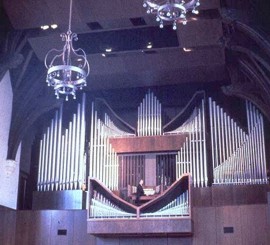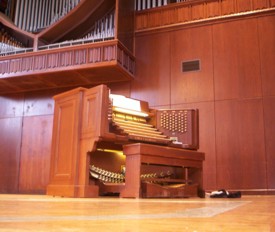University President Albert Murphree received $50,000 for the organ from Dr. Andrew Anderson, a St. Augustine physician, philanthropist, and associate of early Florida developer Henry Flagler. The spacious interior of the University Auditorium, with its elaborate wood-carvings and roomy galleries, offered a congenial home.
 Tonal plans for Florida were prepared by William Zeuch of Boston's famous Skinner Organ Company, which built and installed the original instrument in early 1925. The organ was first played publicly on June 7th, 1925, at the annual University Commencement Convocation. A musical landmark for its day, the organ was designed and voiced at the zenith of orchestral-imitative or "symphonic" organ design in this country, and is mentioned in such reference works as Orpha Ochse's The History of the Organ in the United States and Charles Callahan's The American Classic Organ. It was heard frequently through the 1930s in recitals by Claude Murphree, University Organist, as well as in early broadcasts over the University's "new" radio station, WRUF. A massive and elaborate organ case was also designed by the architect, but was never built.
Tonal plans for Florida were prepared by William Zeuch of Boston's famous Skinner Organ Company, which built and installed the original instrument in early 1925. The organ was first played publicly on June 7th, 1925, at the annual University Commencement Convocation. A musical landmark for its day, the organ was designed and voiced at the zenith of orchestral-imitative or "symphonic" organ design in this country, and is mentioned in such reference works as Orpha Ochse's The History of the Organ in the United States and Charles Callahan's The American Classic Organ. It was heard frequently through the 1930s in recitals by Claude Murphree, University Organist, as well as in early broadcasts over the University's "new" radio station, WRUF. A massive and elaborate organ case was also designed by the architect, but was never built.
During World War II and immediately after, due to institutional economic conditions, the instrument itself was not given proper care. This University treasure was virtually buried behind layers of heavy velour curtains hung in front of the organ to allow theatrical presentations. When the Divison of Music was established in 1948, however, immediate efforts were made to rescue the instrument.
 By the early 1960's the curtains were removed and the Aeolian-Skinner Organ Company began a program of mechanical renovation and tonal rehabilitation to repair the damage caused by the ravages of time and neglected maintenance. By 1976, renovation and air-conditioning of the building had been completed, but the Aeolian-Skinner company was no longer in business. The M. P. Moller Organ Company continued the careful work of restoring the organ to its former excellence as a teaching and recital instrument. Completion of this project was finally assured through funding from University sources, and the entire organ began to be heard in its final form in the Spring of 1992. During March, 1993, a week-long series of events celebrated the place of the Andrew Anderson Memorial Organ in the musical life of this community of scholars.
By the early 1960's the curtains were removed and the Aeolian-Skinner Organ Company began a program of mechanical renovation and tonal rehabilitation to repair the damage caused by the ravages of time and neglected maintenance. By 1976, renovation and air-conditioning of the building had been completed, but the Aeolian-Skinner company was no longer in business. The M. P. Moller Organ Company continued the careful work of restoring the organ to its former excellence as a teaching and recital instrument. Completion of this project was finally assured through funding from University sources, and the entire organ began to be heard in its final form in the Spring of 1992. During March, 1993, a week-long series of events celebrated the place of the Andrew Anderson Memorial Organ in the musical life of this community of scholars.
